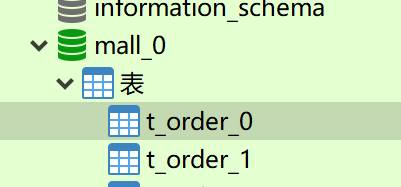springboot+ShardingJDBC+mySql分库分表以及不分库分表操作
数据量达到一定程度的话可能就会进行分库分表,所以最近研究了一个分库分表的插件ShardingJDBC,因为myCat或者其他的开源插件都已经不维护了或者停止更新,目前ShardingJDBC比较活跃,而且不用进行单独部署工作,这点还是比较好的。那么接下来就贴一下代码,看怎么使用它。1.先把表结构贴出来,我的数据库一个部署在linux的腾讯云上,一个部署在本机上第一个数据库是mall...
数据量达到一定程度的话可能就会进行分库分表,所以最近研究了一个分库分表的插件ShardingJDBC,因为myCat或者其他的开源插件都已经不维护了或者停止更新,目前ShardingJDBC比较活跃,而且不用进行单独部署工作,这点还是比较好的。那么接下来就贴一下代码,看怎么使用它。
1.先把表结构贴出来,我的数据库一个部署在linux的腾讯云上,一个部署在本机上第一个数据库是mall_0,表为t_order_0,t_order_1。第二个数据库是mall_1表为t_order_0,t_order_1。稍后在后边附带数据库脚本。


2.首先需要在pom.xml里添加jar包,必然要放的呀~
<!-- 我的springboot版本-->
<parent>
<groupId>org.springframework.boot</groupId>
<artifactId>spring-boot-starter-parent</artifactId>
<version>2.1.4.RELEASE</version>
<relativePath/> <!-- lookup parent from repository -->
</parent>
<!-- MySQL的JDBC驱动包,操作mysql,必然需要mysql啊 -->
<dependency>
<groupId>mysql</groupId>
<artifactId>mysql-connector-java</artifactId>
<scope>runtime</scope>
</dependency>
<!-- shardingjdbc,主角登场 -->
<dependency>
<groupId>io.shardingjdbc</groupId>
<artifactId>sharding-jdbc-core</artifactId>
<version>2.0.3</version>
</dependency>
<!-- druid数据库连接池 -->
<dependency>
<groupId>com.alibaba</groupId>
<artifactId>druid</artifactId>
<version>1.1.6</version>
</dependency>3.jar包下载完毕,就需要写配置文件喽,需要配置数据库连接信息
server:
port: 9999
spring:
application:
name: sharding-jdbc
jackson:
time-zone: GMT+8
date-format: yyyy-MM-dd HH:mm:ss
default-property-inclusion: non_null
datasource:
type: com.alibaba.druid.pool.DruidDataSource
ds0:
url: jdbc:mysql://localhost:3306/mall_0?serverTimezone=UTC
driverClassName: com.mysql.cj.jdbc.Driver
username: root
password: root
ds1:
url: jdbc:mysql://xxx:3307/mall_1?serverTimezone=UTC
driverClassName: com.mysql.cj.jdbc.Driver
username: root
password: root
4.就需要启动注入方式将分库分表规则写入,再把dataSorce连接加入规则,添加类ShardingConfig
package com.itdf.config;
import java.sql.SQLException;
import java.util.HashMap;
import java.util.Map;
import java.util.Properties;
import java.util.concurrent.ConcurrentHashMap;
import javax.sql.DataSource;
import io.shardingjdbc.core.api.ShardingDataSourceFactory;
import io.shardingjdbc.core.api.config.ShardingRuleConfiguration;
import io.shardingjdbc.core.api.config.TableRuleConfiguration;
import io.shardingjdbc.core.api.config.strategy.InlineShardingStrategyConfiguration;
import org.springframework.beans.factory.annotation.Autowired;
import org.springframework.beans.factory.annotation.Qualifier;
import org.springframework.beans.factory.annotation.Value;
import org.springframework.context.annotation.Bean;
import org.springframework.context.annotation.Configuration;
import com.alibaba.druid.filter.Filter;
import com.alibaba.druid.filter.stat.StatFilter;
import com.alibaba.druid.pool.DruidDataSource;
import com.google.common.collect.Lists;
import org.springframework.context.annotation.Primary;
/**
* 配置分库分表操作
* 首先第一步,先到配置文件去获取两个数据源的连接信息
* 第二步设置分库分表的规则
* 第三步将规则放入ShardingJDBC配置里,然后可以设置分库分表的sql显示等等
* 之后将数据源信息都分库分表信息全部传入ShardingJDBC配置,返回给我们DataSource资源
* @Author df
* @Date 2019/8/28 14:17
* @Version 1.0
*/
@Configuration
public class ShardingConfig {
@Value("${spring.datasource.ds0.url}")
private String ds0_url;
@Value("${spring.datasource.ds0.driverClassName}")
private String ds0_driverClassName;
@Value("${spring.datasource.ds0.username}")
private String ds0_username;
@Value("${spring.datasource.ds0.password}")
private String ds0_password;
@Value("${spring.datasource.ds1.url}")
private String ds1_url;
@Value("${spring.datasource.ds1.driverClassName}")
private String ds1_driverClassName;
@Value("${spring.datasource.ds1.username}")
private String ds1_username;
@Value("${spring.datasource.ds1.password}")
private String ds1_password;
/**
* shardingjdbc数据源
*
* @return
*/
@Bean
@Primary
public DataSource dataSource() throws SQLException {
// 封装dataSource
Map<String, DataSource> dataSourceMap = new HashMap<>();
DruidDataSource dataSource0 = createDb0();
dataSourceMap.put("ds0", dataSource0);
DruidDataSource dataSource1 = createDb1();
dataSourceMap.put("ds1", dataSource1);
// 设置分库分表规则
TableRuleConfiguration tableRuleConf = getUserTableRuleConfiguration();
// 将规则写入ShardingDataSource
ShardingRuleConfiguration shardingRuleConf = new ShardingRuleConfiguration();
shardingRuleConf.getTableRuleConfigs().add(tableRuleConf);
Properties p = new Properties();
p.setProperty("sql.show", Boolean.TRUE.toString());
// 获取数据源对象
try {
return ShardingDataSourceFactory.createDataSource(dataSourceMap, shardingRuleConf, new ConcurrentHashMap(), p);
} catch (SQLException e) {
e.printStackTrace();
}
return null;
}
/**
* 设置表的node
*
* @return
*/
private TableRuleConfiguration getUserTableRuleConfiguration() {
TableRuleConfiguration tableRuleConfiguration = new TableRuleConfiguration();
// 设置逻辑表 如:t_user
tableRuleConfiguration.setLogicTable("t_order_");
// 设置数据节点 数据源从ds0-ds1 数据表从t_user0-t_user1
/**
* 分库分表设置ds${0..1}.t_user${0..1}
* 分表设置ds0.t_order_${0..1} 因为要指定具体的库么
*/
tableRuleConfiguration.setActualDataNodes("ds${0..1}.t_order_${0..1}");
// 设置纵列名称 如:id
tableRuleConfiguration.setKeyGeneratorColumnName("order_id");
/**
* 设置分库策略,根据哪个字段进行分库操作。
* 如果织只进行分表,可以注释分库或者不写分库
* 分库原则:字段%2为1进编号1库,字段%2为0进编号0库
*/
tableRuleConfiguration.setDatabaseShardingStrategyConfig(new InlineShardingStrategyConfiguration("order_id", "ds${order_id%2}"));
/**
*设置分表策略,根据哪个字段进行分表操作,分表原则:字段%2为1进编号1库,字段%2为0进编号0库
*/
tableRuleConfiguration.setTableShardingStrategyConfig(new InlineShardingStrategyConfiguration("user_id", "t_order_${user_id%2}"));
return tableRuleConfiguration;
}
/**
* 注入第一个数据源
*
* @return
*/
private DruidDataSource createDb0() {
// 配置第一个数据源
DruidDataSource dataSource = new DruidDataSource();
dataSource.setDriverClassName(ds0_driverClassName);
dataSource.setUrl(ds0_url);
dataSource.setUsername(ds0_username);
dataSource.setPassword(ds0_password);
dataSource.setProxyFilters(Lists.newArrayList(statFilter()));
// 每个分区最大的连接数
dataSource.setMaxActive(20);
// 每个分区最小的连接数
dataSource.setMinIdle(5);
return dataSource;
}
/**
* 注入第二个数据源
*
* @return
*/
private DruidDataSource createDb1() {
// 配置第一个数据源
DruidDataSource dataSource = new DruidDataSource();
dataSource.setDriverClassName(ds1_driverClassName);
dataSource.setUrl(ds1_url);
dataSource.setUsername(ds1_username);
dataSource.setPassword(ds1_password);
dataSource.setProxyFilters(Lists.newArrayList(statFilter()));
// 每个分区最大的连接数
dataSource.setMaxActive(20);
// 每个分区最小的连接数
dataSource.setMinIdle(5);
return dataSource;
}
@Bean
public Filter statFilter() {
StatFilter filter = new StatFilter();
filter.setSlowSqlMillis(5000);
filter.setLogSlowSql(true);
filter.setMergeSql(true);
return filter;
}
}
5.这样配置就可以了,直接该怎么写就怎么写插入查询语句,还按照一个表一样查询就可以了,我先贴入我的service
public interface userService {
public void testInsert(String name, int cityId, int sex) throws SQLException;
public List getAll() throws SQLException;
}6.userService实现类,添加和查询接口
@Override
public void testInsert1(int userid, String status) throws SQLException {
Connection connection = shardingConfig.dataSource().getConnection();
// t_order_逻辑表
PreparedStatement preparedStatement = connection.prepareStatement("insert into t_order_(user_id,status) values(" + userid + ",'" + status + "')");
preparedStatement.executeUpdate();
preparedStatement.close();
connection.close();
}
@Override
public List getAllt_order() throws SQLException {
PreparedStatement pstmt = shardingConfig.dataSource().getConnection().prepareStatement("select * from t_order_ ");
ResultSet resultSet = pstmt.executeQuery();
List list = new ArrayList();
while (resultSet.next()) {
Map map = new HashMap();
map.put("order_id", resultSet.getLong("order_id"));
map.put("user_id", resultSet.getLong("user_id"));
map.put("status", resultSet.getString("status"));
list.add(map);
// System.out.println(resultSet.getLong("order_id") + ":" + resultSet.getLong("user_id"));
}
resultSet.close();
shardingConfig.dataSource().getConnection().close();
return list;
}7.controller里外部调用测试分库分表ok不,创建shardingController类
@RequestMapping("/add1")
@ResponseBody
public String add(int userid, String status) {
try {
userService.testInsert1(userid, status);
} catch (SQLException e) {
e.printStackTrace();
}
return "success";
}
@RequestMapping("/getAll_order")
@ResponseBody
public List getAll_order() {
try {
return userService.getAllt_order();
} catch (SQLException e) {
e.printStackTrace();
}
return null;
}8.然后就可以进行测试了,访问接口添加

9.查看数据库,规则是根据主键id分库,id是主键生成分布式id,这个id%2为0所以进入第0个库也就是mall_0,根据userid进行分表,我添加的是1那么1%2=1所以被分到mall_0的1表也就是t_order_1

10.然后我们查询一下,查询出来了,很简单把!

11.接下来我不想分库只想分表怎么办,把上方的代码修改一下就可以了,将之前的方法里getUserTableRuleConfiguration修改一下就好了, tableRuleConfiguration.setActualDataNodes("ds0.t_order_${0..1}");这里就指定第一个数据源库了,因为不分库了,然后将分库策略注释调就ok了
private TableRuleConfiguration getUserTableRuleConfiguration() {
TableRuleConfiguration tableRuleConfiguration = new TableRuleConfiguration();
// 设置逻辑表 如:t_user
tableRuleConfiguration.setLogicTable("t_order_");
// 设置数据节点 数据源从ds0-ds1 数据表从t_user0-t_user1
/**
* 分库分表设置ds${0..1}.t_user${0..1}
* 分表设置ds0.t_order_${0..1} 因为要指定具体的库么
*/
tableRuleConfiguration.setActualDataNodes("ds0.t_order_${0..1}");
// 设置纵列名称 如:id
tableRuleConfiguration.setKeyGeneratorColumnName("order_id");
/**
* 设置分库策略,根据哪个字段进行分库操作。
* 如果织只进行分表,可以注释分库或者不写分库
* 分库原则:字段%2为1进编号1库,字段%2为0进编号0库
*/
//tableRuleConfiguration.setDatabaseShardingStrategyConfig(new InlineShardingStrategyConfiguration("order_id", "ds${order_id%2}"));
/**
*设置分表策略,根据哪个字段进行分表操作,分表原则:字段%2为1进编号1库,字段%2为0进编号0库
*/
tableRuleConfiguration.setTableShardingStrategyConfig(new InlineShardingStrategyConfiguration("user_id", "t_order_${user_id%2}"));
return tableRuleConfiguration;
}之后就自己测试把,我这边测试是ok的,由于时间有限,那么根据时间分库分表查询就留到下一章节把
差点忘了把数据库脚本给你们
SET NAMES utf8mb4;
SET FOREIGN_KEY_CHECKS = 0;
DROP TABLE IF EXISTS `t_order_0`;
CREATE TABLE `t_order_0` (
`order_id` bigint(20) NOT NULL,
`user_id` int(11) NOT NULL,
`status` varchar(50) CHARACTER SET utf8mb4 COLLATE utf8mb4_unicode_ci NULL DEFAULT NULL,
PRIMARY KEY (`order_id`) USING BTREE
) ENGINE = InnoDB CHARACTER SET = utf8mb4 COLLATE = utf8mb4_unicode_ci ROW_FORMAT = Dynamic;
DROP TABLE IF EXISTS `t_order_1`;
CREATE TABLE `t_order_1` (
`order_id` bigint(20) NOT NULL,
`user_id` int(11) NOT NULL,
`status` varchar(50) CHARACTER SET utf8mb4 COLLATE utf8mb4_unicode_ci NULL DEFAULT NULL,
PRIMARY KEY (`order_id`) USING BTREE
) ENGINE = InnoDB CHARACTER SET = utf8mb4 COLLATE = utf8mb4_unicode_ci ROW_FORMAT = Dynamic;
SET FOREIGN_KEY_CHECKS = 1;
更多推荐
 已为社区贡献2条内容
已为社区贡献2条内容








所有评论(0)